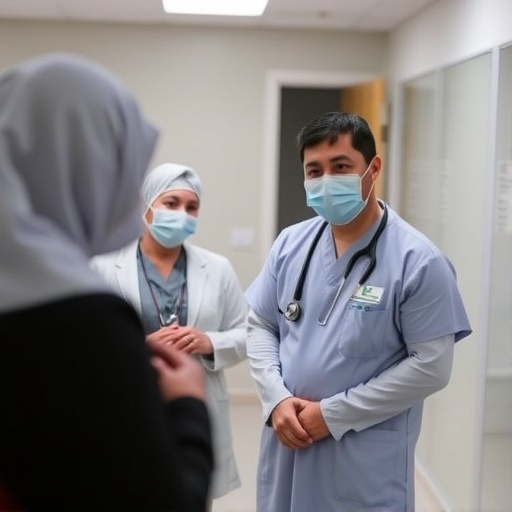Burnout Among Oncology Nurses and Technicians in Morocco: A Critical Analysis of Prevalence, Risk Factors, and Structural Equation Modeling
Burnout, a multifaceted psychological syndrome characterized by emotional exhaustion, depersonalization, and reduced personal accomplishment, remains a pervasive challenge within the healthcare sector worldwide. Its impact is particularly acute in oncology, a specialty marked by intense patient suffering, complex treatments, and continuous emotional demands. A groundbreaking study by researchers from the University Mohammed V of Rabat, led by Imane Errami, delves into the prevalence and underlying risk factors of burnout among oncology nurses, technicians, and administrative staff in Morocco. This research, published in Volume 12 of Oncoscience in July 2025, utilizes an innovative analytical framework to decipher the intricate relationships between burnout dimensions and their contributing elements.
The study was conducted at the National Institute of Oncology in Rabat, Morocco’s premier cancer treatment center. From September to December 2024, a cross-sectional analysis involving 91 healthcare professionals was undertaken, employing the Maslach Burnout Inventory (MBI), a validated psychometric instrument widely recognized for its precision in assessing burnout symptomatology. Beyond mere prevalence statistics, the study innovatively applied structural equation modeling (SEM) to unravel the causal and correlational pathways linking the core elements of burnout—emotional exhaustion (EE), depersonalization (DP), and personal accomplishment (PA).
Findings indicate an alarming incidence of burnout within the cohort, with over 60% manifesting severe burnout symptoms. Emotional exhaustion was particularly pronounced, affecting more than 70% of participants at moderate to high levels. This exhaustion appears to act as a pivotal driver in the burnout cascade, precipitating depersonalization — characterized by emotional detachment and cynicism towards patients — evident in over half the sample. Interestingly, reduced personal accomplishment, frequently conceptualized as a decline in professional efficacy and self-worth, was reported by roughly 25%, suggesting differential impacts of burnout dimensions on healthcare workers’ self-perception.
Demographically, the study uncovered a disproportionate vulnerability among younger staff members and women, with nurses bearing the brunt of burnout compared to other occupational groups within the oncology center. Additionally, frequent nocturnal shifts and irregular working hours exacerbated symptoms, hinting at the circadian rhythm disruptions and sleep deprivation’s critical role in psychological distress. These findings highlight the intersectionality of occupational, gender, and age-related risk factors that compound occupational strain in oncology settings.
Beyond psychological metrics, the study contextualizes burnout within the broader scope of workplace environment and lifestyle factors. A significant number of participants reported inadequate sleep quantity and quality, low engagement in physical activity, and dissatisfaction with remuneration and workplace conditions. These stressors reflect systemic deficits that extend beyond individual capacities, underscoring the need for institutional reforms rather than solely individualized coping strategies.
The application of structural equation modeling in this context offers valuable insight into the complex interplay among burnout components. Emotional exhaustion emerged as the nexus from which depersonalization and diminished personal accomplishment stem, corroborating theoretical models positing EE as the foundational burnout dimension. This hierarchical relationship highlights potentially targeted intervention points where alleviating emotional exhaustion may mitigate subsequent adverse outcomes.
The study’s implications resonate beyond Morocco’s borders, aligning with global concerns about healthcare worker well-being amid increasing patient demands and constrained resources. The authors advocate for comprehensive institutional interventions, emphasizing workload reduction, enhancement of working conditions, financial incentives, and sustained psychological support. Such measures reflect best practices suggested by international guidelines aimed at organizational-level burnout mitigation, contrasting with the ineffective paradigm placing responsibility primarily on individual resilience.
Importantly, the study contextualizes burnout within the oncology domain’s unique psychological burdens, where exposure to patient mortality, chronic illness trajectories, and emotionally taxing communications compound stressors. The fact that over 80% of participants expressed intentions to leave the profession shines a spotlight on retention challenges that could jeopardize oncology healthcare capacity and compromise patient outcomes.
This research contributes significantly to the limited body of literature addressing burnout in African healthcare settings, where sociocultural and economic conditions may add layers of complexity to occupational stress. By elucidating the multidimensional etiology of burnout through rigorous methodological approaches, it sets the stage for evidence-based policies tailored to healthcare infrastructures with limited resources.
Future research directions should explore longitudinal assessments to capture burnout trajectories over time and evaluate the efficacy of proposed institutional interventions. Moreover, integrating physiological markers such as cortisol levels and circadian rhythm assessments could enrich understanding of biopsychosocial pathways influencing burnout progression.
In conclusion, the study by Errami et al. spotlights the critical need to recognize and address burnout among frontline oncology healthcare workers in Morocco. By deploying advanced statistical modeling alongside meticulous psychological assessment, it delivers an urgent call to action for healthcare administrators, policymakers, and professional bodies. Ensuring the sustainability of oncology care hinges on systemic improvements that safeguard the mental health and job satisfaction of those who provide life-saving therapies daily.
Subject of Research: People
Article Title: Burnout among oncology nurses and technicians in Morocco: Prevalence, risk factors, and structural equation modeling
News Publication Date: 31-Jul-2025
Web References: http://dx.doi.org/10.18632/oncoscience.623
Image Credits: Copyright: © 2025 Errami et al. This is an open access article distributed under the terms of the Creative Commons Attribution License (CC BY 4.0).
Keywords: cancer, burnout, oncology, healthcare professionals, risk factors




